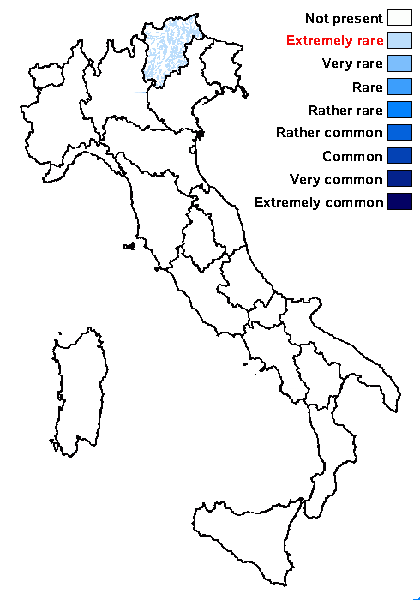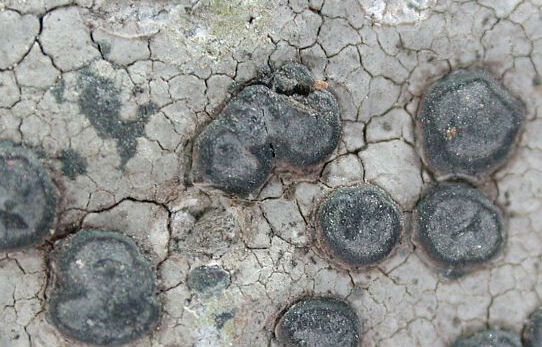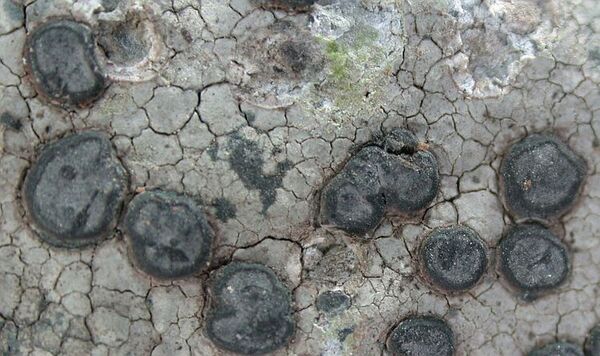Porpidia contraponenda (Arnold) Knoph & Hertel
in Hertel & Knoph, Mitt. bot. Staatss. München, 20: 477, 1984. Basionym: Lecidea contraponenda Arnold - Verh. zool.-bot. Ges. Wien, 36: 79, 1886.
Synonyms:
Distribution: N - TAA.
Description: Thallus crustose, episubstratic, rather thick, rimose to rimose-areolate, the areoles polygonal, slightly convex, sometimes minutely papillate to verrucose, whitish, grey-white or cream-coloured, rarely delimited by a thin dark prothallus (especially when forming mosaics); soredia rarely present, blue-grey. Medulla white, I-. Apothecia lecideine, often confluent, rounded or irregular in outline, long remaning slightly immersed in the thallus, finally sometimes subsessile, 0.3-1(-1.5) mm across, with a concave to finally slightly convex, black but sometimes bluish-pruinose disc and a rather thick, slightly raised, finally often excluded proper margin. Proper exciple brown-black in outer part, dark brown within, the outer hyphae to c. 6 µm thick; epithecium olive-green to greenish-brown, N+ purple-red; hymenium colourless, 60-130 μm high; paraphyses coherent, 1.5-2 μm thick at mid-level, branched and anastomosing, the apical cells only slightly swollen; hypothecium dark brown, 65-75 μm high. Asci 8-spored, elongate-clavate, with a thin, outer amyloid layer and a thickened tholus penetrated by a pore, the sides of which are strongly amyloid, Porpidia-type. Ascospores 1-celled, hyaline, ellipsoid, 13-21(-25) x 5-9(-11) µm, halonate at least when young. Photobiont chlorococcoid. Spot tests: cortex and medulla K-, C-, KC-, P-. Chemistry: 2’-0-methylmicrophyllinate, 2’-0-methylmicrophyllinic acid and an unknown major depside.Note: on siliceous rocks near the ground, e.g. on large pebbles, in humid-moist situations, in open forests on track sides and in shrubland, most frequent in upland areas but generally rare.
Growth form: Crustose
Substrata: rocks
Photobiont: green algae other than Trentepohlia
Reproductive strategy: mainly sexual
Commonnes-rarity: (info)
Alpine belt: absent
Subalpine belt: extremely rare
Oromediterranean belt: absent
Montane belt: extremely rare
Submediterranean belt: absent
Padanian area: absent
Humid submediterranean belt: absent
Humid mediterranean belt: absent
Dry mediterranean belt: absent

Predictive model
Growth form: Crustose
Substrata: rocks
Photobiont: green algae other than Trentepohlia
Reproductive strategy: mainly sexual
Commonnes-rarity: (info)
Alpine belt: absent
Subalpine belt: extremely rare
Oromediterranean belt: absent
Montane belt: extremely rare
Submediterranean belt: absent
Padanian area: absent
Humid submediterranean belt: absent
Humid mediterranean belt: absent
Dry mediterranean belt: absent

Predictive model
 INDEX FUNGORUM
INDEX FUNGORUM
 GBIF
GBIF
 DOLICHENS
DOLICHENS



